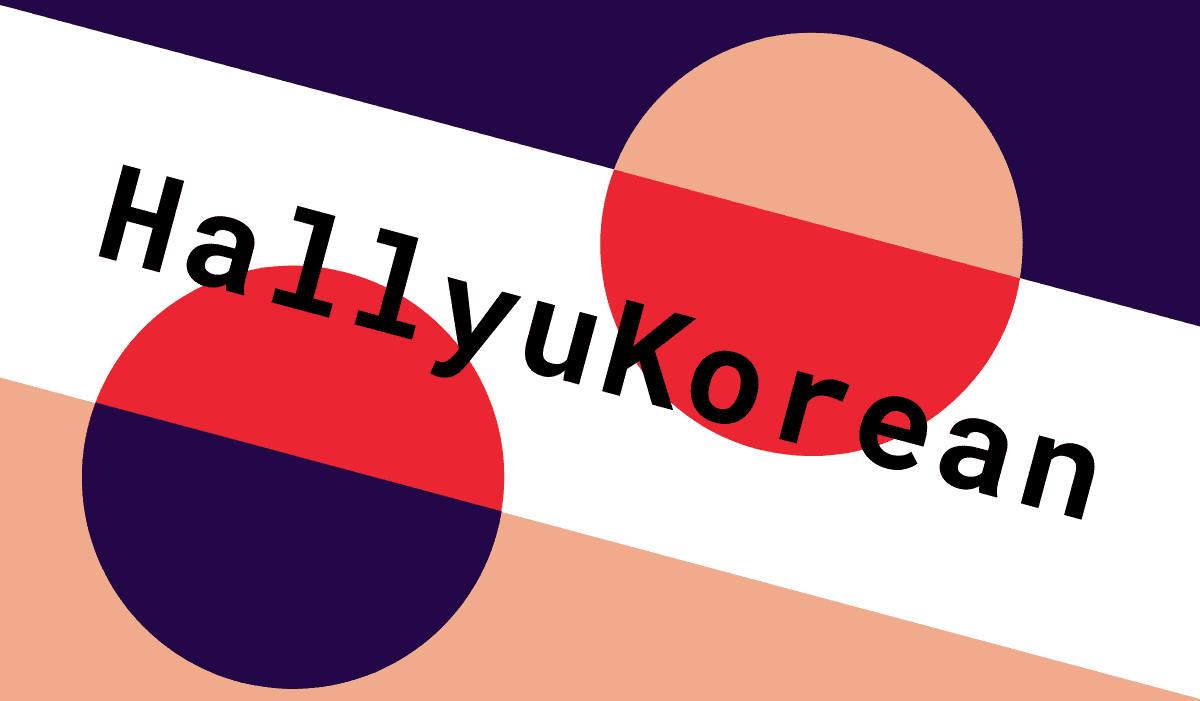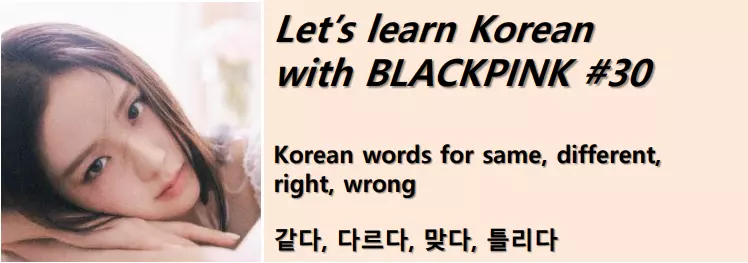Korean words for same, different, right, wrong : 같다, 똑같다, 다르다, 맞다, 틀리다
Let’s learn Korean words for same, different, right, wrong with BLACKPINK lyrics.
Click the play button below to listen to all the BLACKPINK lyrics used in this post.
같다 [gat-tta] to be same
같은 [ga-teon] same
넌 한 줌의 모래 같아
neon han ju-mui mo-rae ga-ta
You’re like a handful of sand
*넌(너(you) + 는(topic particle), =넌) +
한(one) +
줌(a handful) + 의(of) +
모래(sand) +
같아(be same)
똑같다 [ttok-gat-tta] to be the very same
난 어차피 너 따위 있으나 없으나 똑같아
nan eo-cha-pi neo tta-wi i-sseu-na eop-seu-na ttok-ga-ta
Whether I have you or not, it’s the same to me
*난(나(I) + 는(topic particle), =난) +
어차피(anyway) +
너(you) +
따위(and the like)
있으나(있다(be) + 으나(but)) +
없으나(없다(don’t exist) + 으나(but)) +
똑같아(be the very same)
(*Adjective/verb stem + ~(으)나 expresses the contrast between two things or states of affairs.)
다르다 [da-reu-da] to be different
다른 [da-reun] different
다른 남자와는 다르다고
da-reun nam-ja-wa-neun da-reu-da-go
You’re not like other guys
*다른(다르다(be different) + ㄴ(noun modifier)) +
남자(man) + 와(with) + 는(topic particle) +
다르다고(be different)
맞다 [mat-tta] to be right, to be correct, to be hit
엄마 말이 꼭 맞을지도 몰라
eom-ma ma-ri kkok ma-jeul-ji-do mol-la
My mom might be right
*엄마(mom) +
말(talk) + 이(subject particle) +
꼭(exactly) +
맞을지도 몰라(맞다(be right) + ~ㄹ지도 몰라(might))
(*Adding ‘~ㄹ/을지도 모르다’ to a verb stem shows that there is doubt and that something is not certain.)
틀리다 [teul-li-da] to be wrong
틀린 [teul-lin] wrong
우리 이름 틀린다면 뚜두뚜두 맞음
u-ri i-reum teul-lin-da-myeon ttu-du-ttu-du ma-jeum
If you get our name wrong, ddu-du-ddu-du hit
*우리(we) +
이름(name) +
틀린다면(틀리다(be wrong) + 다면(a connective ending used when speaking hypothetically)) +
뚜두뚜두(ddu-du-ddu-du) +
맞음(맞다(be hit) + ~음)
(*Adding ㅁ/음 to the stem of a verb or adjective makes it a noun.
음 for nouns ending in a consonant, ㅁ for nouns ending in a vowel.)
Grammar Reference
*Tense
*Present tense : Adjective/verb stem + ~아/어/해요
*Past tense : Adjective/verb stem + ~았/었/했어요
*Future tense : Adjective/verb stem + ~(으)ㄹ 거예요 / ~ㄹ 게요/ ~겠어요
The basic way to get the verb/adjective stem is to remove 다 from the verb/adjective.
If there is a vowel ㅏ or ㅗ on the final syllable of the adjective/verb stem, 아요(present tense), 았어요(past tense), 을 거예요(future tense) is used.
If there is a vowel other than ㅏ or ㅗ on the final syllable of the adjective/verb, 어요(present tense), 었어요(past tense), ㄹ 거예요(future tense) is used.
Also, if there is 하다 in the adjective/verb, 하다 changes to 해요(present tense), 했어요(past tense), 할 거예요(future tense).
Below you can see the conjugation of 같다, 똑같다, 다르다, 맞다, 틀리다 by tenses.
| Present tense | Past tense | Future tense | |
| 같다 | 같아요 | 같았어요 | 같을 거예요 |
| 똑같다 | 똑같아요 | 똑같았어요 | 똑같을 거예요 |
| 다르다 | 달라요 | 달랐어요 | 다를 거예요 |
| 맞다 | 맞아요 | 맞았어요 | 맞을 거예요 |
| 틀리다 | 틀려요 | 틀렸어요 | 틀릴 거예요 |
*Speech levels
The three most commonly used Korean speech levels are 합쇼체 (formal polite), 해요체 (informal polite) and 해체 (informal plain).
*The formal polite style : Adjective/verb stem + ~(스)ㅂ니다
~(스)ㅂ니다 is used more in formal or public situations including the military, news, reporting presentations, meetings and lectures. It’s mainly used to address large gatherings or people you don’t know personally.
*The informal polite style : Adjective/verb stem + ~아/어/해요
~아/어/해요 is most commonly used in everyday life. Compared to the formal polite style, the informal polite style is softer and less formal, so it is mainly used among family members, friends, shopkeepers and other close acquaintances.
*The informal plain style : Adjective/verb stem + ~아/어/해
As for the informal plain style ~아/어/해, it is mainly used among friends from superiors to people of lower rank and among family members.
Below you can see the conjugation of 같다, 똑같다, 다르다, 맞다, 틀리다 by speech levels.
| Formal polite | Informal polite | Informal plain | |
| 같다 | 같습니다 | 같아요 | 같아 |
| 똑같다 | 똑같습니다 | 똑같아요 | 똑같아 |
| 다르다 | 다릅니다 | 달라요 | 달라 |
| 맞다 | 맞습니다 | 맞아요 | 맞아 |
| 틀리다 | 틀립니다 | 틀려요 | 틀려 |

